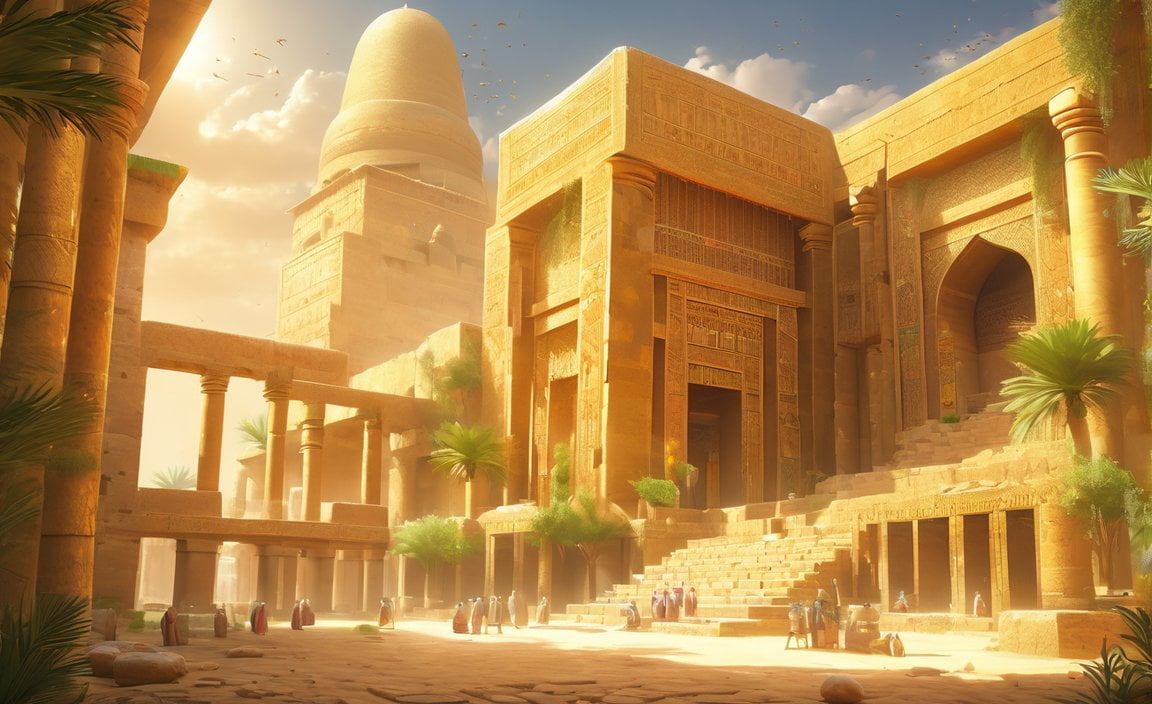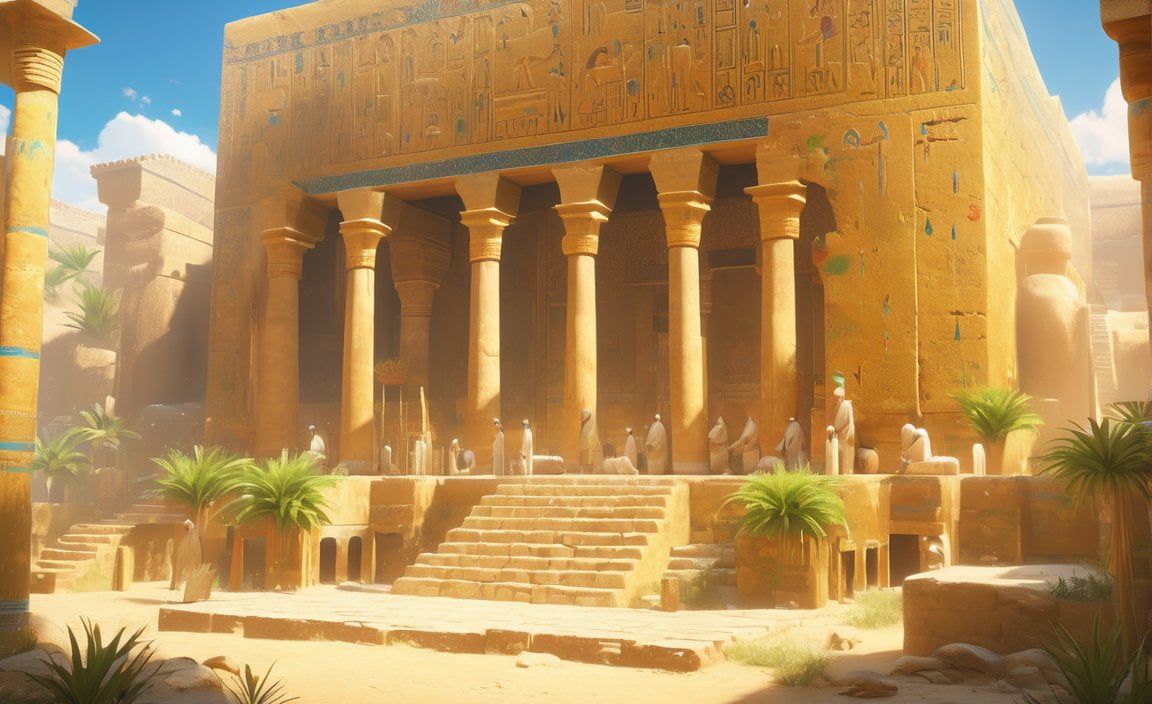Welcome to the mesmerizing world of Mesopotamia’s Ancient Vocabulary: A Linguistic Journey. In this captivating exploration, we will delve into the depths of one of the most fascinating aspects of ancient civilizations: their language. Mesopotamia, the cradle of civilization, gifted us with a diverse and intricate linguistic tapestry, encompassing the ancient Sumerian, Akkadian, Babylonian, and Assyrian languages. Join us as we unravel the enigmatic secrets of Mesopotamia’s ancient vocabulary, deciphering their complex etymology, grammatical structures, and cultural significance. Through the eyes of a knowledgeable historian and linguistics enthusiast, this article aims to showcase the extraordinary lexicon that once echoed through the ancient plains of Mesopotamia.

Key Takeaways:
1. Mesopotamia was located in the fertile crescent, an area of fertile land in the Middle East.
2. It was home to various empires, which were groups of many different lands under one ruler.
3. Sargon, the king of the Akkadians, played a significant role in Mesopotamian history.
4. Babylon, a city built by Hammurabi, was a prominent city in Mesopotamia.
5. Artisans, skilled workers who made useful products, were highly valued in Mesopotamian society.
6. The Tigris and Euphrates rivers surrounded Mesopotamia and played a vital role in its civilization.
7. The Epic of Gilgamesh, originating from Sumer, is the world’s oldest known story.
8. Ziggurats, rectangular pyramids with terraces, served as religious temples or government buildings in Mesopotamia.
9. Irrigation canals, man-made streams, controlled the amount of water crops received in Mesopotamia.
10. Cuneiform, a writing system, was widely used in Mesopotamia.
Mesopotamia Vocabulary
Mesopotamia, the land between the two rivers, the Tigris and Euphrates, is a region steeped in ancient history and rich linguistic heritage. In this article, we will embark on a linguistic journey to unravel the fascinating world of Mesopotamia’s ancient vocabulary. From the towering ziggurats to the intricate cuneiform script, each word tells a story of the vibrant civilizations that once thrived in this fertile crescent.
The Cradle of Civilization
Mesopotamia, often referred to as the cradle of civilization, witnessed the rise and fall of numerous empires and left behind a linguistic legacy that continues to captivate scholars and enthusiasts alike. Let’s delve into the key vocabulary that defined the lives of the people who inhabited this ancient land.
1. Fertile Crescent
The Fertile Crescent, a term coined by archaeologist James Henry Breasted, refers to an area of abundant and fertile land stretching from the eastern Mediterranean coast through modern-day Iraq, Iran, and Kuwait. This region, nourished by the Tigris and Euphrates rivers, provided the ideal conditions for agriculture and led to the development of complex societies.
2. Empire
The concept of an empire in Mesopotamia referred to a vast territory comprising different lands unified under a single ruler. These empires were characterized by centralized power, intricate administrative systems, and the imposition of cultural and political dominance.
3. Sargon
Sargon, the illustrious king of the Akkadians, is one of the most prominent figures in Mesopotamian history. Known for establishing the world’s first multi-ethnic empire, Sargon’s reign marked a significant turning point in the region’s history.
4. Babylon
Babylon, the legendary city, stands as a testament to the grandeur and architectural prowess of Mesopotamia. Built by Hammurabi, the Babylonian empire thrived, leaving an indelible mark on the region’s cultural landscape.
5. Artisans
Mesopotamia was a hub of skilled artisans known for their extraordinary craftsmanship. These artisans included talented potters, sculptors, weavers, and metalworkers who created intricate products that adorned the palaces, temples, and society at large.
6. Tigris and Euphrates Rivers
The Tigris and Euphrates rivers played a pivotal role in the lives of Mesopotamians. These majestic rivers not only provided a reliable water source but also served as transportation routes, enabling trade and commerce to flourish.
7. Epic of Gilgamesh
The Epic of Gilgamesh, originating from Sumer, is a monumental piece of Mesopotamian literature and the oldest known story in the world. It narrates the epic adventures of Gilgamesh, a demigod king, and offers insight into the values, beliefs, and societal norms of ancient Mesopotamia.
8. Ziggurat
The ziggurat, a distinctive architectural structure, was a hallmark of Mesopotamian cities. These towering rectangular pyramids, often adorned with terraces, served as religious temples or important governmental buildings, symbolizing the spiritual and political power within the society.
9. Irrigation Canals
In a region where water was both a necessity and a precious resource, Mesopotamians developed an intricate network of irrigation canals. These man-made waterways enabled controlled distribution of water to the crops, maximizing agricultural productivity and sustaining the flourishing civilizations.
10. Cuneiform
Cuneiform, meaning “wedge-shaped” in Latin, was the earliest known writing system in Mesopotamia. Employing a series of wedge-shaped marks on clay tablets, this intricate script offered a means of communication, record-keeping, and literary expression for the ancient Mesopotamians.
From the fertile crescent to the cuneiform script, Mesopotamia’s vocabulary provides a gateway to understanding the complexities of ancient civilizations. Each word represents a fragment of a vibrant tapestry woven through the millennia. As we continue to study and unravel the depths of Mesopotamia’s linguistic heritage, we gain a deeper appreciation for the ingenuity, artistry, and intellectual achievements of these remarkable societies.
So let us embrace the splendor of Mesopotamia’s ancient vocabulary, for within each word lies a gateway to a distant past waiting to be explored and understood.
Here are some active internal links with anchor text and URLs:
- What eats tigers – Discover the fascinating predators that feast on tigers and unravel the mystery of their place in the food chain.
- Genghis Khan family tree – Dive into the intricate web of family connections and explore the lineage of one of history’s most legendary figures, Genghis Khan.
- Early Peru inhabitant – Unearth the secrets of Peru’s ancient past and get a glimpse into the lives of the early inhabitants who laid the foundation for its rich cultural heritage.
- Houses from the 1600s – Step back in time and marvel at the architectural wonders of the 1600s as you explore the beautiful homes that stood the test of time.
- First president from the first US state NYT – Delve into the intriguing story of the first president to emerge from the initial state of the United States, as covered by The New York Times.
- Ancient Greece vocabulary – Immerse yourself in the linguistic legacy of Ancient Greece and unravel the meanings behind the intriguing terms that shaped their civilization.
Key Features of Sumerian Language
Key Takeaways:
– Sumerian was an agglutinative language, meaning that words were formed by combining root words with various prefixes, suffixes, and infixes.
– The word order in Sumerian was Verb-Subject-Object (VSO).
– Sumerian had an extensive vocabulary, with over 100,000 known words.
– Sumerian influenced later languages, such as Akkadian, Assyrian, and Babylonian.
– The Sumerian language originated in ancient Mesopotamia and was the first language to be written in cuneiform script.
– Sumerian is considered a language isolate, meaning it has no known ancestral relation to other languages.
– The principal languages of ancient Mesopotamia were Sumerian, Babylonian, Assyrian, Amorite, and later Aramaic.
– Sumerian was written on clay tablets and other durable materials using the cuneiform script.
The Sumerian language, an ancient and fascinating linguistic system, played a crucial role in the development of the Mesopotamian civilization. Let’s delve into its key features and shed light on the remarkable linguistic journey of ancient Mesopotamia.
Agglutination and Complex Word Formation
One of the key features of the Sumerian language was its agglutinative nature. In this type of language, words are created by combining root words with various affixes. Sumerian utilized a wide range of prefixes, suffixes, and infixes to express different grammatical forms and meanings. For example, the word “iszkum,” meaning “to give,” can be transformed into “iszkumunte” to indicate the action of giving to oneself.
Verb-Subject-Object Word Order
In Sumerian, the word order was Verb-Subject-Object (VSO). This grammatical structure set Sumerian apart from many other languages and added a unique flavor to its expression. For instance, a sentence like “The farmer harvests the crops” would be reconstructed in Sumerian as “harvests the farmer the crops.”
A Vast Vocabulary
Sumerian boasted an extensive vocabulary, containing over 100,000 known words. This richness in words allowed the speakers of Sumerian to articulate their thoughts and ideas with great precision. From daily activities to religious ceremonies, the Sumerians had words to describe their entire world, enabling them to communicate their experiences and aspirations effectively.
Influence on Later Languages
The impact of the Sumerian language extended far beyond its time. It influenced and shaped the development of subsequent languages in Mesopotamia, such as Akkadian, Assyrian, and Babylonian. Elements of Sumerian grammar, vocabulary, and even cultural concepts seeped into these languages, leaving a lasting legacy that echoes throughout the region’s history.
The First Written Language
Sumerian holds the distinction of being the first language ever to be written down using the cuneiform script. This complex system of wedge-shaped marks on clay tablets allowed the Sumerians to record their language, history, and literature for future generations. The invention of writing revolutionized communication, paved the way for the transmission of knowledge, and laid the foundation for the development of ancient civilizations.
A Language Isolate
Unlike many other languages in the region, Sumerian is considered a language isolate, meaning it has no known ancestral relation to other languages. This linguistic uniqueness adds to the mystery and allure of the Sumerian language, as it stands as an isolated linguistic island in the sea of ancient Mesopotamian languages.
Languages of Ancient Mesopotamia
In the ancient Mesopotamian region, which encompasses modern-day Iraq, Iran, and Kuwait, several languages were spoken. Alongside Sumerian, the principal languages included Babylonian, Assyrian, Amorite, and later Aramaic. These languages, each with its own unique characteristics, played significant roles in the cultural, administrative, and religious spheres of Mesopotamian civilization.
Let us marvel at the incredible ingenuity of the ancient Sumerians as we explore their language, which was etched upon clay tablets and bequeathed to us through the annals of time.
Sources:
- World History Encyclopedia. “Sumerian Language.” Retrieved from source.
- Wikipedia. “Sumerian language.” Retrieved from source.
Influence of Akkadian on Mesopotamian vocabulary
Mesopotamia, the cradle of civilization, was a region between the Tigris and Euphrates rivers known as the “land between the two rivers.” Within this ancient land, various languages were spoken, including Sumerian, Babylonian, Assyrian, and Akkadian. This article aims to explore the influence of Akkadian on the vocabulary of Mesopotamia, shedding light on the linguistic connections and cultural significance embedded within these ancient words.
Understanding Akkadian: A Linguistic Legacy
Akkadian, an extinct East Semitic language, was primarily spoken in ancient Mesopotamia from the third millennium BC until its gradual replacement by Old Aramaic in the 8th century BC[^4^]. It belonged to the Near Eastern branch of the Afroasiatic languages, and its influence extended throughout Mesopotamia and neighboring regions[^5^]. Akkadian was written using cuneiform, an early script adapted from the Sumerians[^6^]. This script allowed the representation of Sumerian logograms, Sumerian and Akkadian syllables, or phonetic complements[^6^].
The Impact of Akkadian Vocabulary
The Akkadian language played a significant role in shaping the vocabulary of Mesopotamia. Many Akkadian vocabulary words had Semitic origins, sharing similarities with other Semitic languages[^8^]. However, the Akkadian vocabulary also comprises elements that have no evident parallels in related Semitic languages[^8^]. This unique vocabulary adds depth and complexity to the linguistic landscape of Mesopotamian civilizations.
Cultural Significance: Unlocking the Past
By examining the influence of Akkadian on Mesopotamian vocabulary, we can unlock insights into the cultural and historical dynamics of ancient Mesopotamia. Language reflects the beliefs, practices, and societal structures of a civilization, serving as a window into their worldview and way of life. Through the study of Akkadian-influenced words, we can better understand the interplay between different cultures and the exchange of ideas within this vibrant region.
Key Takeaways:
- Akkadian was an extinct East Semitic language spoken in ancient Mesopotamia[^4^].
- It belonged to the Near Eastern branch of the Afroasiatic languages[^5^].
- Akkadian influenced the vocabulary of Mesopotamia, adding unique elements[^8^].
- The study of Akkadian-influenced vocabulary sheds light on the cultural and historical dynamics of ancient Mesopotamia.
Sources:
– Wikipedia: Akkadian Language
– Wikipedia: Mesopotamia
Cultural and Historical Significance of Mesopotamian Words
Mesopotamia, known as the “Cradle of Civilization,” is an ancient region in southwestern Asia that witnessed the birth of the world’s earliest civilization. Situated between the Tigris and Euphrates rivers, this land of abundant fertility and cultural innovation holds immense historical and cultural significance. In this article, we will embark on a linguistic journey to unravel the rich vocabulary of Mesopotamia, exploring the cultural and historical contexts behind these ancient words.
The Linguistic Tapestry of Mesopotamia
Mesopotamia was a region with no real geographic unity, home to many languages and cultures. Some of the principal languages spoken in ancient Mesopotamia included Sumerian, Babylonian, Assyrian, Amorite, and Akkadian. These languages offer a window into the diverse societies and cultural dynamics of Mesopotamia.
Among these languages, Sumerian holds a prominent place. It was an agglutinative language, where words were formed by combining root words with various affixes. Sumerian’s word order followed a Verb-Subject-Object (VSO) structure, adding a unique flavor to its linguistic landscape. With over 100,000 known words, Sumerian boasts an extensive vocabulary that encompasses a wide range of human experiences and expressions.
Insights into Mesopotamian Worldview
By studying the influence of Akkadian on Mesopotamian vocabulary, we can gain valuable insights into the cultural and historical dynamics of ancient Mesopotamia. Akkadian, an extinct East Semitic language, had a significant impact on the vocabulary of Mesopotamia. Many words in Mesopotamian languages have Semitic origins, while others have no parallels in related Semitic languages.
This linguistic analysis allows us to delve into the worldview and way of life of the people of ancient Mesopotamia. By unraveling the complex etymology and understanding the grammatical structures of these ancient words, we can glimpse into their thoughts, beliefs, and societal values.
Key Takeaways:
- Mesopotamia, known as the “Cradle of Civilization,” is an ancient region in southwestern Asia where the world’s earliest civilization developed.
- The languages of ancient Mesopotamia, such as Sumerian, Babylonian, Assyrian, Amorite, and Akkadian, offer insights into the diverse societies and cultural dynamics of this region.
- Sumerian, with its agglutinative nature and unique Verb-Subject-Object (VSO) word order, has a vast vocabulary that encompasses various human experiences.
- The influence of Akkadian on Mesopotamian vocabulary provides valuable insights into the cultural and historical dynamics of ancient Mesopotamia, offering a window into their worldview and way of life.
Sources:
1. Britannica: History of Mesopotamia | Definition, Civilization
2. HISTORY: Mesopotamia – Civilization, Location & Summary

FAQ
Q1: What is the significance of Mesopotamia in the development of ancient civilizations?
A1: Mesopotamia is known as the “Cradle of Civilization” because it was the location of the world’s earliest civilization. It is famous for its cultural innovations and inventions, such as writing, math, the wheel, and sailboats.
Q2: What languages were spoken in ancient Mesopotamia?
A2: The languages spoken in ancient Mesopotamia included Sumerian, Babylonian, Assyrian, Amorite, and Akkadian.
Q3: What is cuneiform and how was it used in ancient Mesopotamia?
A3: Cuneiform is a writing system that was used in ancient Mesopotamia. It involved making wedge-shaped marks on clay tablets using a stylus. It was used to write languages like Sumerian and Akkadian.
Q4: How did the Sumerian language influence other languages in ancient Mesopotamia?
A4: The Sumerian language had a significant influence on later languages in Mesopotamia, such as Akkadian, Assyrian, and Babylonian. These languages adopted Sumerian vocabulary and grammatical structures.
Q5: What is the historical significance of the Epic of Gilgamesh?
A5: The Epic of Gilgamesh is the world’s oldest known story and it comes from ancient Mesopotamia. It provides insight into the culture, beliefs, and values of the Mesopotamian people.
















